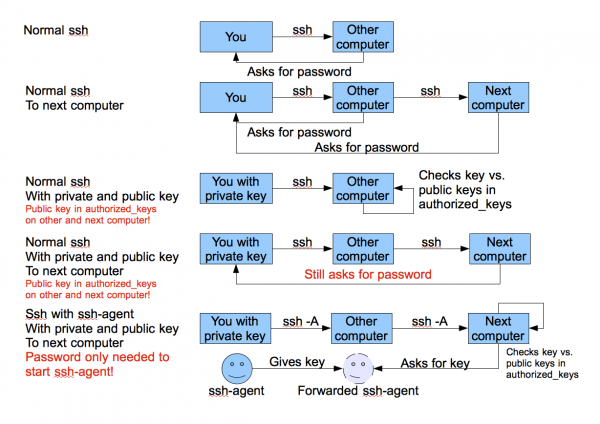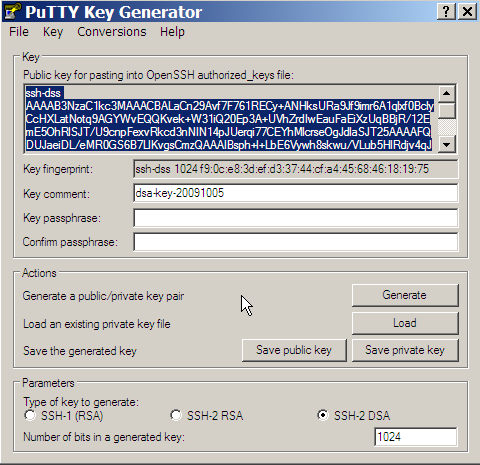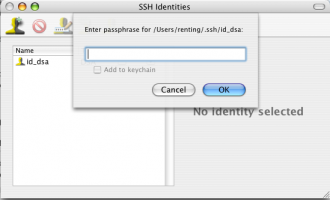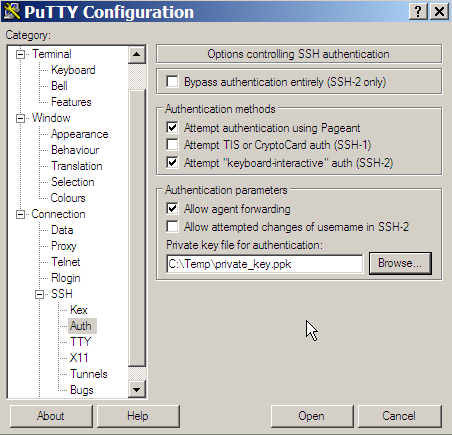This is an old revision of the document!
SSH Usage on CEP
We use the Secure Shell (ssh) on CEP to connect to different systems. This page explains how this can be used without having to supply a password each time you want to connect to a system. The image below tries to explain the process:
With normal ssh you always have to give a password. If you use a private and public key, you can access systems where your public key is in $HOME/.ssh/authorized_keys from the system where you have the private key. With the ssh-agent explained below, you can ssh to any system without having to supply a password. (very useful to run things on nodes of a cluster, or other remote machines.
Generating keys
Linux or OS X
The first thing you need to do is generate an authorisation key using the DSA algorithm, which means you need to do the following once. You need to have a somewhat recent version of OpenSSL on your system for this to work:
ssh-keygen -tdsa cp .ssh/id_dsa.pub .ssh/authorized_keys
Use cat or some editor like vi, kate or emacs if authorized keys already exists and can't be simply copied. Copy your .ssh/authorized_keys to the $HOME of each system you want access to. Please make sure you use a passphrase to encrypt your private key, to prevent easy access. When using the instructions below on the ssh-agent, you'll only have to provide it once each time you use the systems.
Windows
Windows users can download the Putty toolkit from http://www.chiark.greenend.org.uk/~sgtatham/putty/download.html. Please select the Windows Installer as that contains the whole package.
After installing, you'll have the Putty program, and several help programs such as Pageant.
Select from the Programs menu the Putty section and select PuttyGen.
- Select in the
Paramaterssection the key type (e.g., SSH-2 DSA). - Press the
Generatebutton. - Now you'll have to move your mouse over the grey area below the progress bar.
- Once done, you'll get a screen like the one shown below.
- Enter a passphrase (and confirm).
- Now you can save the public and private key files in a location of your choice.
Using an SSH-Agent
An ssh-agent is a small program that when you start work is used to unlock the passphrase protected private key you generated above. The ssh-agent will from that point on automatically supply the right answers to any ssh session, if you use ssh -A each time you connect to another system.
Detailed information on how to setup ssh agent forwarding can be found here and here.
Linux
The ssh-agent runs in the user's local PC, laptop, or terminal. Authentication data need not be stored on any other machine, and authentication passphrases never go over the network. Also, the connection to the agent is forwarded over SSH remote logins, and the user can thus use the privileges given by the identities anywhere in the network in a secure way.
If you start the ssh-agent it creates a socket in /tmp and then generates a few commands on stdout which serve to set environmental variables and to tell you which PID the agent has. An example:
SSH_AUTH_SOCK=/tmp/ssh-jpIaV4861/agent.4861; export SSH_AUTH_SOCK; SSH_AGENT_PID=4862; export SSH_AGENT_PID; echo Agent pid 4862;
By 'eval'uating this code, the variables SSH_AUTH_SOCK and SSH_AGENT_PID will be set. You can use the SSH_AGENT_PID, for example, to kill the agent when you log off. The agent itself recognises the variable and commits suicide when you type:
ssh-agent -k
The SSH_AUTH_SOCK variable is mainly used by the program ssh-add, which uses it to determine with which agent to communicate. To get your agent running in (t)csh type:
eval `ssh-agent` ssh-add
Please note the back-quotes. If you have bash, you might use the more readable:
eval $(ssh-agent) ssh-add
OS X
Recent versions of OS X (10.5 “Leopard” or later) have ssh-agent integration built in – and integrated with the system keychain for passphrase management. See this blog post for details.
On older versions of OS X, install SSH Agent 1.1 or SSHKeyChain and set it to Open at Login or use the same commands as on Linux.
If you have this set up, then you can easily make bookmarks in iTerm to access machines and forward the ssh-agent. An example with some of the LOFAR machines is shown in the image below.
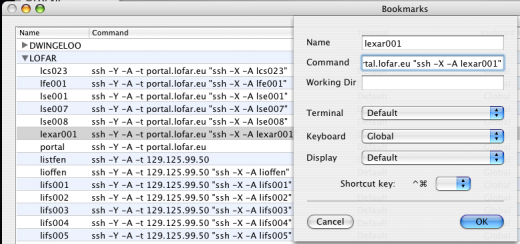
Windows
Windows users that have downloaded the Putty package (see above) and have keys generated and saved on their system can use the Pageant program in the Putty distribution.
To use it, select Programs → Putty → Pageant. Pageant will start as an icon in your taskbar. The icon is this: ![]()
Double-click the icon to open the console. Then use the Add Key button to select the Private key file on your system. You will be asked to enter the passphrase.
Once you have done this, Pageant will be used to forward the keys to any system you have access to, and on which you have added the public key in the $HOME/.ssh/authorized_keys file.
To enable forwarding of your key in Putty, make sure that the session you use in Putty has the option 'Agent Forwarding' enabled and the location of the key file filled in the Connection/SSH/Auth section (see screenshot below).
SSH Port forwarding / tunneling
With port forwarding it is possible to, e.g., copy data with scp from a host that is not directly reachable by your local system. For instance, if you want to copy data from one of the cluster node systems to your local host, you first have to pass the data to the portal.lofar.eu, as you can only access that system directly from the outside world. However, data space is not available on that system, so you are stuck…at least you think so..!
The solution is available and it uses port forwarding, or ssh tunneling.
First, set up the connection. Say, you want to set up a tunnel to lce019 through lofar.portal.eu. Of course, for this to work, you need an account on both systems.
> ssh -L 10000:lce019.lofar:22 -l <username> portal.lofar.eu
In this example, we use the local port 10000, but this could be any portnumber above 1024, as long as it is not used/claimed by another process. The portnumber 22 is the default ssh port that you will use for scp.
You are probably asked to provide a password; this is the password for the portal.lofar.eu, and after providing it you will have logged into the portal. Leave this session open, as it defines the tunnel you use. You have now set up your tunnel.
To use the tunnel with scp, you can give the following commands. To copy files from your local system to the lce019 you type:
> scp -P 10000 <localfile> localhost:<remotefile>
And to copy files from the remote host to your local host:
> scp -P 10000 localhost:<remotefile> <localfile>
After you have finished, you can close the session that defined the tunnel.
